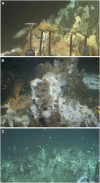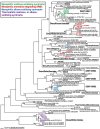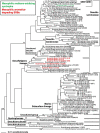Microbial Hydrocarbon Degradation in Guaymas Basin-Exploring the Roles and Potential Interactions of Fungi and Sulfate-Reducing Bacteria
- PMID: 35356530
- PMCID: PMC8959706
- DOI: 10.3389/fmicb.2022.831828
Microbial Hydrocarbon Degradation in Guaymas Basin-Exploring the Roles and Potential Interactions of Fungi and Sulfate-Reducing Bacteria
Abstract
Hydrocarbons are degraded by specialized types of bacteria, archaea, and fungi. Their occurrence in marine hydrocarbon seeps and sediments prompted a study of their role and their potential interactions, using the hydrocarbon-rich hydrothermal sediments of Guaymas Basin in the Gulf of California as a model system. This sedimented vent site is characterized by localized hydrothermal circulation that introduces seawater sulfate into methane- and hydrocarbon-rich sediments, and thus selects for diverse hydrocarbon-degrading communities of which methane, alkane- and aromatics-oxidizing sulfate-reducing bacteria and archaea have been especially well-studied. Current molecular and cultivation surveys are detecting diverse fungi in Guaymas Basin hydrothermal sediments, and draw attention to possible fungal-bacterial interactions. In this Hypothesis and Theory article, we report on background, recent results and outcomes, and underlying hypotheses that guide current experiments on this topic in the Edgcomb and Teske labs in 2021, and that we will revisit during our ongoing investigations of bacterial, archaeal, and fungal communities in the deep sedimentary subsurface of Guaymas Basin.
Keywords: Guaymas Basin; fungi; hydrocarbon; microbial interaction; sulfate-reducing bacteria.
Copyright © 2022 Edgcomb, Teske and Mara.
Conflict of interest statement
The authors declare that the research was conducted in the absence of any commercial or financial relationships that could be construed as a potential conflict of interest.
Figures





References
-
- Al-Nasrawi H. (2012). Biodegradation of crude oil by fungi isolated from the Gulf of Mexico. J. Bioremed. Biodeg. 2012:147. 10.4172/2155-6199.1000147 - DOI
-
- Azam F., Fenchel T., Field J. G., Gray J. S., Meyer-Reil L. A., Thingstad F. (1983). The ecological role of water column microbes in the sea. Mar. Ecol. Prog. Ser. 10 257–263.
-
- Bazylinski D. A., Farrington J. W., Jannasch H. W. (1988). Hydrocarbons in surface sediments from a Guaymas Basin hydrothermal vent site. Org. Geochem. 12 547–558. 10.1016/0146-6380(88)90146-5 - DOI
LinkOut - more resources
Full Text Sources

